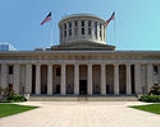
Nathan Kelley
Encyclopedia
Nathan B. Kelley was a United States
architect
and builder. He was a prolific architect whose designs dominated the cityscape of Columbus, Ohio at the middle of the 19th century.
, when he was 27 years of age. At about the same time, he was named as (construction) superintendent of the State School for the Blind. In the 1840s, city directories list him as surveyor
and engineer
for the city of Columbus.
 His most significant works are the interior space and mechanical systems of the Ohio Statehouse
His most significant works are the interior space and mechanical systems of the Ohio Statehouse
. This massive government building was erected between 1839 and 1861, with Kelley serving as one of four principal architects between 1854 and 1858. When he came to the project, Kelley basically began from scratch, as his predecessors had taken all plans and working drawings away with them. Walls and some flooring were in place, and first steps in erecting iron
truss
es for the roof had begun. Undaunted by the great scope of work before him, he saw it as fitting challenge for his abilities, stating the project was "a rare field for the exercise of ingenuity and invention in the correction of mistakes, careless conclusions and want of foresight." Seeing the building had no provision for heating
or ventilation
, Kelley designed an innovative steam heating system that was highly effective, at a time when central heating was a rare and expensive luxury. He was responsible for the finishing touches on the exterior of the building, as well as the design and engineering of most of the interior spaces.
Kelley was forced off the project after repeated conflicts with the commission that oversaw the work for the state government. The major source of controversy arose from Kelley's florid and elegant plasterwork
and high level of ornamentation
, which reflects the use of Classical
motifs combined with the decorative sensibilities of the Victorian
era, and contrasted sharply with the restrained Greek Revival exterior of the structure. Kelley envisioned a highly decorated interior, in accord with the elegance and noble purpose of the building itself, and the stature of such a place in the developing state. He believed if the work were done in the "bare and bald" style, which the government commission overseeing the work favored, it would meet with little acceptance and have to soon be done over at great cost and effort. The chambers used by the House and Senate are basically as Kelley pictured them, though with some modern additions and alteration of layout, but with decorative scheme intact. They give some indication of what he would have done as far as finishes in the central rotunda
, which he planned to be the most ornate and opulent space in the building. He made further recommendations that monumental painting
s or mural
s be installed in the rotunda (the panels intended for this purpose were never hung with art as he wished), and hoped that the government "would see fit to honor the nation's great general" (George Washington
) with a statue in the rotunda, which also never came to pass.
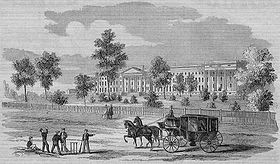
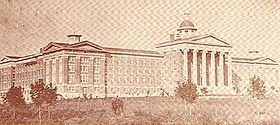 In Columbus, Kelley was also responsible for the State School for the Blind, Lunatic Asylum, Franklin County (Ohio) Court House (1840), many schools and churches, commercial buildings, and a variety of private residences. His residence for railroad executive Benjamin E. Smith was completed in 1871, and is still in use as a home for The Columbus Club. Another surviving building is the Hayden Block, a yellow sandstone building on Broad Street directly to the north of the statehouse. Originally a bank and office building, it still is used for those purposes. Immediately after his dismissal from the statehouse project, he left the Columbus area and worked in southwest Ohio and in Kentucky
In Columbus, Kelley was also responsible for the State School for the Blind, Lunatic Asylum, Franklin County (Ohio) Court House (1840), many schools and churches, commercial buildings, and a variety of private residences. His residence for railroad executive Benjamin E. Smith was completed in 1871, and is still in use as a home for The Columbus Club. Another surviving building is the Hayden Block, a yellow sandstone building on Broad Street directly to the north of the statehouse. Originally a bank and office building, it still is used for those purposes. Immediately after his dismissal from the statehouse project, he left the Columbus area and worked in southwest Ohio and in Kentucky
, where he was responsible for a state asylum in Hopkinsville
, which still stands and houses patients. Called the Western State Hospital, it is visible on satellite map websites.
In his long career, Kelley combined a tenacious ability to champion his own personal artistic choices with a willingness to recognize changes in popular taste and fashion. In his obituary in the Columbus Statesman newspaper, his work was called "of the substantial kind, with a most desirable absence of that confusion of styles which condemns so many expensive buildings."
Many of Kelley's buildings in Columbus and other locations did not survive, as growth and development overtook them. His life and career are an example of how someone well regarded and respected in his own time can come to be almost anonymous a century after his death. No image of the man himself exists and his grave
in Greenlawn Cemetery
is unmarked.
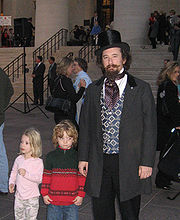 Kelley married the former Malinda Hufford in 1832, shortly before they moved to Columbus. The Hufford family was of Swiss extraction, having originally settled in Virginia
Kelley married the former Malinda Hufford in 1832, shortly before they moved to Columbus. The Hufford family was of Swiss extraction, having originally settled in Virginia
before coming to Ohio in 1831. Kelley is listed as head of household in the 1840, 1850 and 1870 U.S. censuses as residing in Columbus, and he and his family are enumerated twice in 1860 both in Columbus and in Christian County, Kentucky
. Census records, burial records and city directories make it possible to state that Kelley had two sons, William George (1843–1867) and James H (1847–1876). He had at least one daughter, perhaps two, but records are contradictory. Martha Jane Kelley (1835–1836) is buried in Greenlawn beside her father and brothers. A Maria Kelley, aged 3, is part of the 1850 census listing, but appears in no other census listings, and is not mentioned in probate records when Kelley died.
James H. Kelley is listed in city directories as clerk to his father, or architect in his own right. The very real possibility that there are no direct descendants of Nathan B. Kelley is evidenced by the fact that his wife is mentioned as having resided with her brother Daniel Hufford for six years in his obituary dated 1891. It is unlikely that Malinda Kelley would have had to rely upon the charity of her brother if any of her own children had been able to provide for her. This is confirmed by the fact that probate records for the estate of Nathan Kelley indicate he died intestate, Malinda Kelley requested not to serve as executor, and James H. Kelley requested that duty as the only child and heir. Malinda Hufford Kelley died in 1893.
Kelley was a member of the Independent Order of Odd Fellows
(IOOF), a fraternal organization devoted to the welfare and betterment of its members and society at large. He was a founder of the first IOOF lodge in Columbus, the group for most of its life meeting in a building at the corner of High and State Streets that also contained a bank and Kelley's offices.
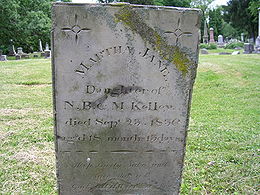 As is typical of the time period, there was little consistency in the spelling of personal names. In various sources, it is spelled either Kelley or Kelly. Burial records from Greenlawn Cemetery and his daughter's tombstone there, as well as his grandfather’s biography from an early history of Warren County have it as Kelley, while his obituary
As is typical of the time period, there was little consistency in the spelling of personal names. In various sources, it is spelled either Kelley or Kelly. Burial records from Greenlawn Cemetery and his daughter's tombstone there, as well as his grandfather’s biography from an early history of Warren County have it as Kelley, while his obituary
in a Columbus newspaper and his own signature on working drawings omit the final ‘e’ and spell the name Kelly. In some sources he is also known as N.B. Kelley.
Kelley was of Anglo-Irish
heritage, his great-grandfather John Kelley leaving Belfast, Ireland to settle in New Castle, Delaware
. The architect was named for his paternal grandfather, Nathan Kelley (1760–1845), who left Delaware to head west, first to south western Pennsylvania
, where he married Hannah Miller, and then to Warren County in what was then the Northwest Territory
. The elder Nathan was a prosperous farmer who served the area as justice of the peace
, appeals court judge
and state representative
. Nathan B. Kelley was the third of 8 children born to James Miller Kelley and Rebecca Ludlum Kelley. The Ludlum line can be traced back to Derbyshire, England. The Kelley family had a demonstrated habit of sharing names among generations and branches of the family, so that Nathan had both uncles and brothers with the same names. He had a nephew, Nathan Kelley Hufford, named in his honor. His elder brothers Thomas Jefferson Kelley and George Washington Kelley demonstrate the patriotic zeal felt in the still young nation.
Kelley's younger brother James Finley Kelley (1816–1894) was also a resident of Columbus, Ohio, where with his wife, the former Eliza Van Horn, he raised three children: Albert (b.1845), a railroad brakeman, Virginia (b.1857), a school teacher, and Rebecca (b.1859). Census records list James? F. Kelley as a pattern maker and metal foundry
supervisor, so it is likely he was involved in the statehouse project in some capacity.
United States
The United States of America is a federal constitutional republic comprising fifty states and a federal district...
architect
Architect
An architect is a person trained in the planning, design and oversight of the construction of buildings. To practice architecture means to offer or render services in connection with the design and construction of a building, or group of buildings and the space within the site surrounding the...
and builder. He was a prolific architect whose designs dominated the cityscape of Columbus, Ohio at the middle of the 19th century.
Life and work
Little personal information exists about Kelley before he began a major commission in 1835 for the Central Ohio Lunatic AsylumPsychiatric hospital
Psychiatric hospitals, also known as mental hospitals, are hospitals specializing in the treatment of serious mental disorders. Psychiatric hospitals vary widely in their size and grading. Some hospitals may specialise only in short-term or outpatient therapy for low-risk patients...
, when he was 27 years of age. At about the same time, he was named as (construction) superintendent of the State School for the Blind. In the 1840s, city directories list him as surveyor
Surveying
See Also: Public Land Survey SystemSurveying or land surveying is the technique, profession, and science of accurately determining the terrestrial or three-dimensional position of points and the distances and angles between them...
and engineer
Engineer
An engineer is a professional practitioner of engineering, concerned with applying scientific knowledge, mathematics and ingenuity to develop solutions for technical problems. Engineers design materials, structures, machines and systems while considering the limitations imposed by practicality,...
for the city of Columbus.

Ohio Statehouse
The Ohio Statehouse, located in Columbus, Ohio, is the house of government for the state of Ohio. The Greek Revival building houses the Ohio General Assembly and the ceremonial offices of the Governor, Lieutenant Governor, Treasurer, and Auditor....
. This massive government building was erected between 1839 and 1861, with Kelley serving as one of four principal architects between 1854 and 1858. When he came to the project, Kelley basically began from scratch, as his predecessors had taken all plans and working drawings away with them. Walls and some flooring were in place, and first steps in erecting iron
Iron
Iron is a chemical element with the symbol Fe and atomic number 26. It is a metal in the first transition series. It is the most common element forming the planet Earth as a whole, forming much of Earth's outer and inner core. It is the fourth most common element in the Earth's crust...
truss
Truss
In architecture and structural engineering, a truss is a structure comprising one or more triangular units constructed with straight members whose ends are connected at joints referred to as nodes. External forces and reactions to those forces are considered to act only at the nodes and result in...
es for the roof had begun. Undaunted by the great scope of work before him, he saw it as fitting challenge for his abilities, stating the project was "a rare field for the exercise of ingenuity and invention in the correction of mistakes, careless conclusions and want of foresight." Seeing the building had no provision for heating
Central heating
A central heating system provides warmth to the whole interior of a building from one point to multiple rooms. When combined with other systems in order to control the building climate, the whole system may be a HVAC system.Central heating differs from local heating in that the heat generation...
or ventilation
Ventilation (architecture)
Ventilating is the process of "changing" or replacing air in any space to provide high indoor air quality...
, Kelley designed an innovative steam heating system that was highly effective, at a time when central heating was a rare and expensive luxury. He was responsible for the finishing touches on the exterior of the building, as well as the design and engineering of most of the interior spaces.
Kelley was forced off the project after repeated conflicts with the commission that oversaw the work for the state government. The major source of controversy arose from Kelley's florid and elegant plasterwork
Plasterwork
Plasterwork refers to construction or ornamentation done with plaster, such as a layer of plaster on an interior wall or plaster decorative moldings on ceilings or walls. This is also sometimes called pargeting...
and high level of ornamentation
Ornament (architecture)
In architecture and decorative art, ornament is a decoration used to embellish parts of a building or object. Large figurative elements such as monumental sculpture and their equivalents in decorative art are excluded from the term; most ornament does not include human figures, and if present they...
, which reflects the use of Classical
Classical architecture
Classical architecture is a mode of architecture employing vocabulary derived in part from the Greek and Roman architecture of classical antiquity, enriched by classicizing architectural practice in Europe since the Renaissance...
motifs combined with the decorative sensibilities of the Victorian
Victorian architecture
The term Victorian architecture refers collectively to several architectural styles employed predominantly during the middle and late 19th century. The period that it indicates may slightly overlap the actual reign, 20 June 1837 – 22 January 1901, of Queen Victoria. This represents the British and...
era, and contrasted sharply with the restrained Greek Revival exterior of the structure. Kelley envisioned a highly decorated interior, in accord with the elegance and noble purpose of the building itself, and the stature of such a place in the developing state. He believed if the work were done in the "bare and bald" style, which the government commission overseeing the work favored, it would meet with little acceptance and have to soon be done over at great cost and effort. The chambers used by the House and Senate are basically as Kelley pictured them, though with some modern additions and alteration of layout, but with decorative scheme intact. They give some indication of what he would have done as far as finishes in the central rotunda
Rotunda (architecture)
A rotunda is any building with a circular ground plan, sometimes covered by a dome. It can also refer to a round room within a building . The Pantheon in Rome is a famous rotunda. A Band Rotunda is a circular bandstand, usually with a dome...
, which he planned to be the most ornate and opulent space in the building. He made further recommendations that monumental painting
Painting
Painting is the practice of applying paint, pigment, color or other medium to a surface . The application of the medium is commonly applied to the base with a brush but other objects can be used. In art, the term painting describes both the act and the result of the action. However, painting is...
s or mural
Mural
A mural is any piece of artwork painted or applied directly on a wall, ceiling or other large permanent surface. A particularly distinguishing characteristic of mural painting is that the architectural elements of the given space are harmoniously incorporated into the picture.-History:Murals of...
s be installed in the rotunda (the panels intended for this purpose were never hung with art as he wished), and hoped that the government "would see fit to honor the nation's great general" (George Washington
George Washington
George Washington was the dominant military and political leader of the new United States of America from 1775 to 1799. He led the American victory over Great Britain in the American Revolutionary War as commander-in-chief of the Continental Army from 1775 to 1783, and presided over the writing of...
) with a statue in the rotunda, which also never came to pass.


Kentucky
The Commonwealth of Kentucky is a state located in the East Central United States of America. As classified by the United States Census Bureau, Kentucky is a Southern state, more specifically in the East South Central region. Kentucky is one of four U.S. states constituted as a commonwealth...
, where he was responsible for a state asylum in Hopkinsville
Hopkinsville, Kentucky
Hopkinsville is a city in Christian County, Kentucky, United States. The population was 31,577 at the 2010 census. It is the county seat of Christian County.- History :...
, which still stands and houses patients. Called the Western State Hospital, it is visible on satellite map websites.
In his long career, Kelley combined a tenacious ability to champion his own personal artistic choices with a willingness to recognize changes in popular taste and fashion. In his obituary in the Columbus Statesman newspaper, his work was called "of the substantial kind, with a most desirable absence of that confusion of styles which condemns so many expensive buildings."
Many of Kelley's buildings in Columbus and other locations did not survive, as growth and development overtook them. His life and career are an example of how someone well regarded and respected in his own time can come to be almost anonymous a century after his death. No image of the man himself exists and his grave
Grave (burial)
A grave is a location where a dead body is buried. Graves are usually located in special areas set aside for the purpose of burial, such as graveyards or cemeteries....
in Greenlawn Cemetery
Greenlawn Cemetery, Columbus, Ohio
Green Lawn Cemetery is a large and historically significant burial ground in Central Ohio, United States. Located in the southern section of Columbus, Ohio , it is the final resting place for many local notables and well-known figures from national history...
is unmarked.
Personal life

Virginia
The Commonwealth of Virginia , is a U.S. state on the Atlantic Coast of the Southern United States. Virginia is nicknamed the "Old Dominion" and sometimes the "Mother of Presidents" after the eight U.S. presidents born there...
before coming to Ohio in 1831. Kelley is listed as head of household in the 1840, 1850 and 1870 U.S. censuses as residing in Columbus, and he and his family are enumerated twice in 1860 both in Columbus and in Christian County, Kentucky
Christian County, Kentucky
Christian County is a county located in the U.S. state of Kentucky. It was formed in 1797. As of 2000, its population was 72,265. Its county seat is Hopkinsville, Kentucky...
. Census records, burial records and city directories make it possible to state that Kelley had two sons, William George (1843–1867) and James H (1847–1876). He had at least one daughter, perhaps two, but records are contradictory. Martha Jane Kelley (1835–1836) is buried in Greenlawn beside her father and brothers. A Maria Kelley, aged 3, is part of the 1850 census listing, but appears in no other census listings, and is not mentioned in probate records when Kelley died.
James H. Kelley is listed in city directories as clerk to his father, or architect in his own right. The very real possibility that there are no direct descendants of Nathan B. Kelley is evidenced by the fact that his wife is mentioned as having resided with her brother Daniel Hufford for six years in his obituary dated 1891. It is unlikely that Malinda Kelley would have had to rely upon the charity of her brother if any of her own children had been able to provide for her. This is confirmed by the fact that probate records for the estate of Nathan Kelley indicate he died intestate, Malinda Kelley requested not to serve as executor, and James H. Kelley requested that duty as the only child and heir. Malinda Hufford Kelley died in 1893.
Kelley was a member of the Independent Order of Odd Fellows
Independent Order of Odd Fellows
The Independent Order of Odd Fellows , also known as the Three Link Fraternity, is an altruistic and benevolent fraternal organization derived from the similar British Oddfellows service organizations which came into being during the 18th century, at a time when altruistic and charitable acts were...
(IOOF), a fraternal organization devoted to the welfare and betterment of its members and society at large. He was a founder of the first IOOF lodge in Columbus, the group for most of its life meeting in a building at the corner of High and State Streets that also contained a bank and Kelley's offices.
Family name and history

Obituary
An obituary is a news article that reports the recent death of a person, typically along with an account of the person's life and information about the upcoming funeral. In large cities and larger newspapers, obituaries are written only for people considered significant...
in a Columbus newspaper and his own signature on working drawings omit the final ‘e’ and spell the name Kelly. In some sources he is also known as N.B. Kelley.
Kelley was of Anglo-Irish
Anglo-Irish
Anglo-Irish was a term used primarily in the 19th and early 20th centuries to identify a privileged social class in Ireland, whose members were the descendants and successors of the Protestant Ascendancy, mostly belonging to the Church of Ireland, which was the established church of Ireland until...
heritage, his great-grandfather John Kelley leaving Belfast, Ireland to settle in New Castle, Delaware
New Castle, Delaware
New Castle is a city in New Castle County, Delaware, six miles south of Wilmington, situated on the Delaware River. In 1900, 3,380 people lived here; in 1910, 3,351...
. The architect was named for his paternal grandfather, Nathan Kelley (1760–1845), who left Delaware to head west, first to south western Pennsylvania
Western Pennsylvania
Western Pennsylvania consists of the western third of the state of Pennsylvania in the United States. Pittsburgh is the largest city in the region, with a metropolitan area population of about 2.4 million people, and serves as its economic and cultural center. Erie, Altoona, and Johnstown are its...
, where he married Hannah Miller, and then to Warren County in what was then the Northwest Territory
Northwest Territory
The Territory Northwest of the River Ohio, more commonly known as the Northwest Territory, was an organized incorporated territory of the United States that existed from July 13, 1787, until March 1, 1803, when the southeastern portion of the territory was admitted to the Union as the state of Ohio...
. The elder Nathan was a prosperous farmer who served the area as justice of the peace
Justice of the Peace
A justice of the peace is a puisne judicial officer elected or appointed by means of a commission to keep the peace. Depending on the jurisdiction, they might dispense summary justice or merely deal with local administrative applications in common law jurisdictions...
, appeals court judge
Judge
A judge is a person who presides over court proceedings, either alone or as part of a panel of judges. The powers, functions, method of appointment, discipline, and training of judges vary widely across different jurisdictions. The judge is supposed to conduct the trial impartially and in an open...
and state representative
Pennsylvania House of Representatives
The Pennsylvania House of Representatives is the lower house of the bicameral Pennsylvania General Assembly, the legislature of the U.S. state of Pennsylvania. There are 203 members, elected for two year terms from single member districts....
. Nathan B. Kelley was the third of 8 children born to James Miller Kelley and Rebecca Ludlum Kelley. The Ludlum line can be traced back to Derbyshire, England. The Kelley family had a demonstrated habit of sharing names among generations and branches of the family, so that Nathan had both uncles and brothers with the same names. He had a nephew, Nathan Kelley Hufford, named in his honor. His elder brothers Thomas Jefferson Kelley and George Washington Kelley demonstrate the patriotic zeal felt in the still young nation.
Kelley's younger brother James Finley Kelley (1816–1894) was also a resident of Columbus, Ohio, where with his wife, the former Eliza Van Horn, he raised three children: Albert (b.1845), a railroad brakeman, Virginia (b.1857), a school teacher, and Rebecca (b.1859). Census records list James? F. Kelley as a pattern maker and metal foundry
Foundry
A foundry is a factory that produces metal castings. Metals are cast into shapes by melting them into a liquid, pouring the metal in a mold, and removing the mold material or casting after the metal has solidified as it cools. The most common metals processed are aluminum and cast iron...
supervisor, so it is likely he was involved in the statehouse project in some capacity.

